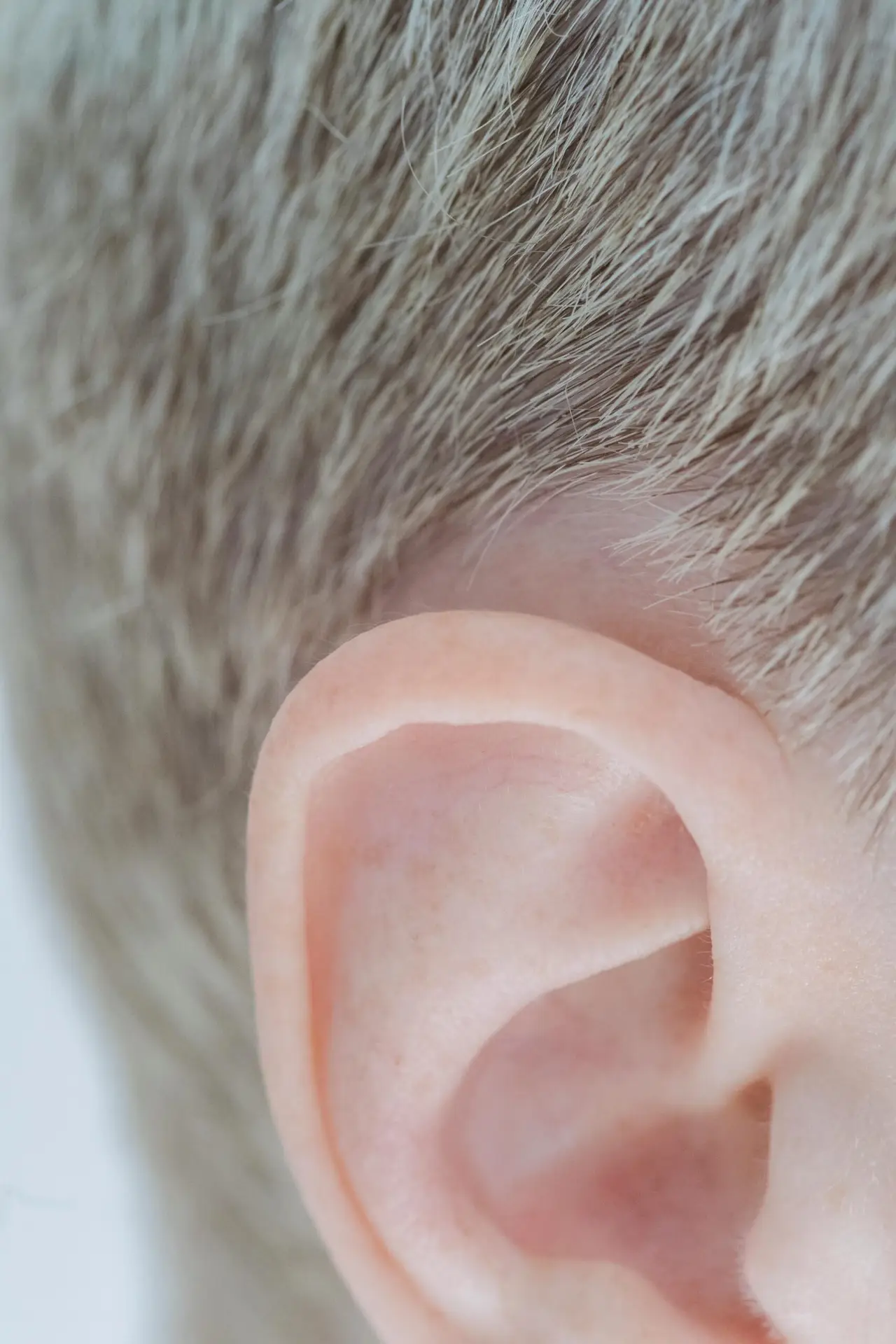
Ear pressure, clicking, popping, and that strange “airplane feeling” are issues that many people in Sarasota, Bradenton, and Lakewood Ranch experience more often than they’d like. For some, it comes with storms, barometric pressure changes, allergies, or sinus congestion. For others, it’s an everyday annoyance that leads to frustration, dizziness, or even chronic headaches.
At Lavender Family Chiropractic in Sarasota, we specialize in identifying the root cause of these issues. While many people think ear pressure is only a sinus or ENT problem, there’s often an overlooked contributor: upper cervical misalignment in the top of the neck. This region plays a critical role in drainage, nerve function, and balance.
In this blog, we’ll explore:
- What causes ear pressure and Eustachian tube dysfunction.
- Why weather and barometric pressure changes make ear pressure worse.
- The role of the upper cervical spine in proper ear and sinus function.
- How gentle upper cervical chiropractic care at Lavender Family Chiropractic helps resolve ear pressure naturally.
- The Top 15 FAQs about ear pressure and how misalignment may be the missing link.
What It Feels Like to Have Ear Pressure
Ear pressure is a sensation that almost everyone experiences at some point, but when it lingers or comes on suddenly, it can feel overwhelming, confusing, and even frightening. Imagine being on an airplane as it begins to descend—your ears feel clogged, muffled, and heavy, as though someone stuffed cotton deep inside them. That’s the most common comparison people make when describing ear pressure, but for many, it’s not just limited to travel.
The feeling can range from mildly annoying to deeply uncomfortable. At times, it feels like your ear is swollen from the inside out, creating a sense of fullness that refuses to go away. You may hear your own voice echoing in your head, a phenomenon called autophony. Every word you speak vibrates inside your ear canal, making conversations disorienting and exhausting. Normal sounds can seem muted, as if you’re underwater, while at other times, small noises become oddly amplified.
With ear pressure, popping and clicking sensations often accompany the fullness. Each attempt to yawn, swallow, or chew gum becomes a conscious effort to “release” the pressure. Sometimes relief comes with a sudden, satisfying pop—but often it doesn’t, leaving you feeling trapped in a cycle of trying and failing to restore balance. This constant pressure can make it hard to focus on daily tasks, leaving you frustrated and drained.
The discomfort can extend beyond just your ears. Many people with ear pressure describe tension in the side of their head, temple, or even jaw. Headaches may arise, and in some cases, dizziness or vertigo join the mix. You might feel like the room is subtly tilting or spinning when you move your head. Barometric pressure changes, like before a thunderstorm, can make the sensation worse, almost as if the weather is squeezing your inner ear from the inside out.
Emotionally, ear pressure can be exhausting. The constant muffled hearing and the sensation that something is “stuck” inside your head create a nagging distraction. It makes social interactions harder—you can’t hear conversations clearly, so you find yourself straining or asking others to repeat themselves. Over time, this can lead to feelings of isolation or irritability.
For some, the sensation is temporary, resolving after a few hours or days. For others, it lingers for weeks or months, affecting sleep, concentration, and overall quality of life. Even simple things, like walking outside on a windy day or riding in the car, may feel more difficult.
At its core, ear pressure feels unnatural—like your body is fighting to equalize something that just won’t balance. It’s a reminder of how delicate the structures of the ear are and how sensitive we are to even small changes in pressure, alignment, or fluid buildup.
Whether mild or severe, ear pressure is not just a physical feeling but an experience that affects your mood, your focus, and your ability to fully engage in life.
Understanding Ear Pressure and Eustachian Tube Dysfunction
The Eustachian tube is a small canal that connects the middle ear to the back of the nose and throat. Its job is to equalize air pressure on both sides of the eardrum and allow fluid drainage.
When the Eustachian tube isn’t working properly, you may experience:
- A feeling of fullness or pressure in the ears.
- Clicking or popping sounds.
- Muffled hearing or temporary hearing loss.
- Ear pain, especially when flying or driving through elevation changes.
- Dizziness or balance issues.
This condition is called Eustachian Tube Dysfunction (ETD), and while it can be triggered by allergies, colds, or sinus infections, it can also be heavily influenced by neurological and structural issues in the upper neck.
Why Ear Pressure Feels Worse During Flights or Storms
You may notice that your symptoms get worse when:
- Flying on an airplane.
- Driving up or down a mountain.
- Storms or barometric pressure changes roll through Sarasota.
That’s because your Eustachian tube has to adapt to external air pressure changes. If it doesn’t open and close properly, your eardrum cannot equalize pressure, leading to discomfort, popping, or pain.
In people with upper cervical misalignment, the nerves controlling these delicate functions may not work at their best. The result? The body struggles to adapt to pressure changes in the environment, leaving you more sensitive to weather shifts.
How Upper Cervical Misalignment Contributes to Ear Pressure
The upper cervical spine (C1 – Atlas and C2 – Axis) is located just beneath the skull. This area protects the brainstem, a vital hub that controls automatic body functions—including drainage pathways, muscle tone around the Eustachian tube, and balance.
When the atlas (C1) is misaligned:
- Drainage may be restricted. Misalignment can impact nerve signals that help regulate the Eustachian tube and surrounding tissues.
- Blood and lymphatic flow can be reduced. This leads to fluid buildup, congestion, and chronic ear fullness.
- Neurological stress builds. The body struggles to adapt to environmental changes like barometric pressure, making ear pressure and headaches worse.
Many patients at Lavender Family Chiropractic in Sarasota come in thinking they have a recurring sinus or ENT problem, only to discover that the root cause is in their upper neck.
The Power of Upper Cervical Chiropractic Care
When most people think of chiropractic care, they picture traditional adjustments that involve twisting, cracking, or popping the spine. While this can help some patients, there’s a more specialized and gentle approach that focuses on the top two bones of the neck: upper cervical chiropractic care. This precise method doesn’t rely on forceful manipulation—instead, it addresses the delicate relationship between the brainstem, nervous system, and spinal alignment. For people struggling with migraines, vertigo, TMJ, post-concussion symptoms, and chronic pain, upper cervical chiropractic care can be life-changing.
What Is Upper Cervical Chiropractic Care?
Upper cervical chiropractic care focuses exclusively on the atlas (C1) and axis (C2), the two vertebrae located at the very top of the spine. These bones play a crucial role in supporting the head, protecting the brainstem, and allowing for free communication between the brain and body.
Unlike general chiropractic adjustments that address multiple regions of the spine, upper cervical care emphasizes restoring alignment and balance in this small but powerful region. Even a tiny misalignment in the upper cervical spine can disrupt nerve communication, blood flow, and overall body function.
Why the Upper Cervical Spine Matters
The upper cervical spine is unique for several reasons:
- Brainstem protection: The brainstem sits just above the atlas and axis. It controls vital functions such as breathing, circulation, digestion, and balance.
- Range of motion: The upper neck allows the head to move in multiple directions. Misalignment here affects posture, balance, and muscle tone throughout the body.
- Neurological impact: Misalignment in this region can create stress on the nervous system, contributing to migraines, vertigo, dizziness, ear pressure, brain fog, and fatigue.
When the atlas or axis shifts even slightly out of position, the body may compensate by tilting, twisting, or altering posture, leading to secondary pain and dysfunction elsewhere.
How Misalignment Happens
Upper cervical misalignment can occur from many different causes, including:
- Car accidents and whiplash injuries.
- Sports injuries or concussions.
- Slips, falls, or physical trauma.
- Poor posture, especially with technology use.
- Stress and repetitive strain on the neck.
Unfortunately, many people don’t feel immediate pain after these events. Instead, they develop symptoms weeks, months, or even years later—headaches, dizziness, TMJ pain, or low back pain that doesn’t respond to conventional treatment.
Symptoms of Upper Cervical Misalignment
Some of the most common conditions linked to upper cervical misalignment include:
- Migraines and chronic headaches.
- Vertigo, dizziness, and balance problems.
- TMJ dysfunction and jaw pain.
- Neck stiffness and pain.
- Post-concussion syndrome.
- Fibromyalgia and chronic fatigue.
- Ear pressure, tinnitus, and sinus issues.
- Neurological conditions such as POTS or dysautonomia.
Because the upper neck is so closely connected to the nervous system, misalignment often leads to wide-ranging symptoms that don’t always seem related to the spine.
The Gentle Approach: No Popping or Twisting
Upper cervical chiropractic is very different from traditional chiropractic. At Lavender Family Chiropractic, we use gentle and precise corrections tailored to each patient’s unique anatomy.
Here’s what sets our approach apart:
- 3D CBCT imaging: We take advanced cone beam CT scans to see the exact misalignment in your upper cervical spine.
- Functional nervous system scans: Our paraspinal infrared thermography (Tytron scans) detect areas of stress and imbalance in the nervous system.
- Gentle adjustments: Corrections are specific and precise—there is no twisting, popping, or cracking.
- Objective progress tracking: We monitor your nervous system and postural balance over time to confirm improvement.
This approach makes care safe for people of all ages—from children to seniors—and especially beneficial for patients with neurological symptoms or sensitive conditions.
Benefits of Upper Cervical Chiropractic Care
Patients who receive upper cervical care often notice improvements not only in their primary complaint but also in overall health and function. Some of the most reported benefits include:
- Fewer migraines and headaches.
- Relief from vertigo and dizziness.
- Clearer thinking and reduced brain fog.
- Better posture and spinal alignment.
- Decreased neck, back, and shoulder pain.
- Improved sleep and energy levels.
- Fewer ear infections or sinus problems in children.
When the nervous system is restored to balance, the body naturally begins to heal and function at its best.
Conditions We See in Sarasota and Bradenton
At Lavender Family Chiropractic, we specialize in helping people who have tried everything else without lasting relief. Common conditions we see include:
- Migraines and headaches: Many patients report decades of migraines resolved after upper cervical adjustments.
- Vertigo and balance disorders: From BPPV to vestibular migraines, we help restore balance by correcting the neck.
- TMJ dysfunction: Jaw pain often improves when the upper cervical spine is properly aligned.
- Post-accident injuries: Whiplash and concussions frequently lead to upper cervical misalignment, which explains lingering symptoms.
Our patients come from Sarasota, Bradenton, Lakewood Ranch, Parrish, Venice, and surrounding areas seeking long-term solutions instead of temporary fixes.
Lavender Family Chiropractic’s Approach to Ear Pressure Relief
At Lavender Family Chiropractic, we specialize in gentle and precise upper cervical chiropractic care that helps restore normal nervous system function and drainage. Unlike traditional chiropractic adjustments that twist or pop the neck, our approach is:
- Safe and gentle: No cracking, twisting, or popping.
- Guided by technology: We use state-of-the-art 3D CBCT imaging to see the exact misalignment in the upper cervical spine.
- Neurologically focused: Our functional nervous system scans (Tytron infrared thermography) measure stress on the nervous system and track progress over time.
- Customized: Each adjustment is tailored to your unique spinal structure.
Patients often report not just improvement in ear pressure, but also relief from dizziness, migraines, sinus congestion, and brain fog—all linked to the same underlying misalignment.
Barometric Pressure, Storms, and Ear Pain in Sarasota
Living in Sarasota, Bradenton, and Lakewood Ranch means dealing with frequent storms and rapid weather changes. Many patients notice that they feel:
- Increased ear pressure before storms.
- Migraines that worsen when barometric pressure drops.
- A sensation of being “off balance” during weather changes.
This isn’t just coincidence. Barometric pressure shifts stress the nervous system. If your upper cervical spine is already misaligned, your body loses adaptability, making symptoms worse. Correcting the misalignment helps restore balance and resilience, so your body can handle weather changes more naturally.
Top 15 FAQs About Ear Pressure and Upper Cervical Misalignment
1. What causes constant ear pressure even without infection?
Chronic ear pressure is often due to Eustachian Tube Dysfunction, allergies, or sinus congestion—but it can also stem from upper cervical misalignment restricting proper drainage.
2. Why do my ears pop when I swallow or yawn?
This is your Eustachian tube trying to equalize pressure. If misalignment interferes with nerve function, the tube may not open and close properly, causing clicking or popping.
3. Can barometric pressure changes cause ear pressure?
Yes. Rapid drops or rises in barometric pressure strain the body’s ability to equalize ear pressure. Misalignment in the neck can magnify this sensitivity.
4. Why does flying make my ears hurt so much?
Because of altitude changes, your Eustachian tube must work harder. If drainage or nerve function is compromised by a neck misalignment, the pressure difference causes pain.
5. Can upper cervical chiropractic help with ear infections?
While chiropractic does not treat infections directly, many patients notice fewer infections once alignment is corrected because drainage improves and fluid doesn’t build up.
6. How does neck misalignment affect ear function?
The atlas and axis vertebrae protect the brainstem, which regulates nerve signals for drainage and balance. Misalignment here disrupts normal ear function.
7. Why do my ears feel full all the time?
Chronic fullness is often due to poor drainage. Correcting spinal misalignment restores normal nerve communication and allows fluid movement.
8. Can ear pressure cause dizziness?
Yes. The ear is closely tied to balance. Many people with ETD or ear pressure also experience vertigo or dizziness, which improves after upper cervical care.
9. Do storms really trigger migraines and ear pressure?
Absolutely. Patients in Sarasota often report migraines and ear pain during storms. Proper alignment reduces nervous system stress, so your body adapts better.
10. What’s the connection between TMJ and ear pressure?
Jaw dysfunction often goes hand-in-hand with upper cervical misalignment. Both can contribute to ear pressure, popping, and discomfort.
11. Will antibiotics fix ear pressure?
Antibiotics only work if there’s an infection. Most chronic ear pressure cases are not infections but structural or neurological issues.
12. Can children benefit from upper cervical care for ear pressure?
Yes! Many children with recurring ear infections or pressure benefit from gentle adjustments that restore proper drainage.
13. How do I know if my ear pressure is from my neck?
If symptoms come with headaches, neck stiffness, dizziness, or worsening during storms, the neck may be involved. Imaging at Lavender Family Chiropractic can confirm.
14. How long does it take to see results with upper cervical care?
Many patients feel improvement within weeks, though long-standing cases may require consistent care over time.
15. Where can I find the best upper cervical chiropractor near me for ear pressure?
If you’re in Sarasota, Bradenton, Lakewood Ranch, or nearby areas, Lavender Family Chiropractic is the trusted choice for advanced upper cervical care.
Patient Success Stories at Lavender Family Chiropractic
We’ve had countless patients come in with ear pressure, dizziness, or “airplane ear” who tried ENT visits, medications, and sinus treatments with little success. After gentle, precise upper cervical adjustments:
- One patient reported her ears no longer felt clogged before every storm.
- Another experienced fewer migraines and was able to fly without pain.
- Parents of children with recurring ear infections noticed fewer episodes after their child’s neck was gently realigned.
Areas We Serve
Lavender Family Chiropractic proudly serves:
- Sarasota, Bradenton, and Lakewood Ranch
- Parrish, Ellenton, Venice, Osprey
- Punta Gorda, St. Petersburg, Siesta Key
- Longboat Key, Lido Key, Myakka City
If you’re searching for “chiropractor Sarasota Florida,” “chiropractor near me,” “upper cervical chiropractor near me,” “vertigo doctor near me,” or “migraine doctor near me”—our office is here to help.
Take the Next Step Toward Relief
If you’re struggling with ear pressure, popping, or weather-related discomfort, don’t settle for temporary relief. The problem may not be in your sinuses or ears at all—it may be in your neck.
At Lavender Family Chiropractic, we use cutting-edge 3D CBCT imaging and nervous system scans to find the exact misalignment causing your symptoms. With gentle upper cervical adjustments, we help restore balance, drainage, and long-term relief.
Lavender Family Chiropractic in Sarasota Florida offers complimentary consultations to learn more about you. Click the link below!
https://intake.chirohd.com/new-patient-scheduling/724/lavender-family-chiropractic
Visit our Website!
To learn more about us go to http://www.chiropractorsarasotaflorida.com
We also service Bradenton, Parrish, Ellenton, Ruskin, Venice, Tampa, St. Pete, Osprey, Longboat, Lakewood Ranch, Myakka City.
If you are not local, visit www.uccnearme.com to find a doctor in your area.
📍 Visit us at: 5899 Whitfield Ave Ste 107, Sarasota, FL 34243
🌐 Learn more: www.chiropractorsarasotaflorida.com
📞 Call today:
📲 Follow us on Instagram @lavenderfamilysrq and TikTok @drrustylavender



